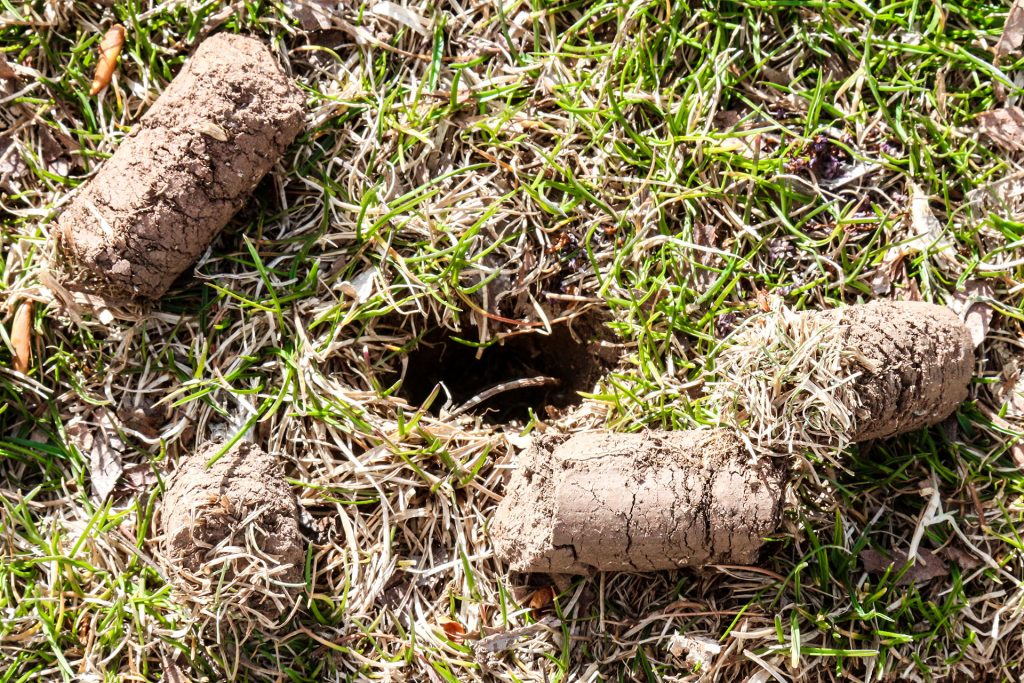
It’s almost time to aerate your TifTuf Bermudagrass lawn. It’s something you see on professional lawns all the time. From pro sports to high school soccer fields, spring is marked by a bunch of little rounds of dirt scattered across a grassy expanse. But what about the lawn just outside your home? Do you really need to aerate? And if you do, how do you aerate effectively? Is it something you can do yourself, or should you hire professionals?
Homeowners have lots of questions about aerating their TifTuf Bermudagrass lawns, so we’ve put together a primer on aerating your lawn. We hope to answer all (or most) of your questions and get you on the path to a beautiful lawn this spring and summer.
![How to Aerate Your TifTuf Bermudagrass Lawn [infographic]](https://theturfgrassgroup.com//wp-content/uploads/2020/03/How-to-Aerate-Your-TifTuf-Bermudagrass-Lawn-infographic.jpg)
What Your Turf Needs to Survive
Your lawn is a living thing. You probably already knew that, but it’s always good to remember that you need to treat your lawn like the living, breathing, growing organism that it is. Your lawn needs a few essential ingredients to survive. It needs nutrients, water, at least a little sun, and air. Without any one of these, your lawn is on the fast track to a brown, patchy, dead expanse. The best way to keep your grass thriving is to ensure that it has all the ingredients needed for grassy life.
Thankfully, the sun usually takes care of itself. If you have a particularly shady environment, it may help to cut back some trees. But TifTuf Bermudagrass is tough, and it can handle shade pretty well.
As for water, it all depends on the weather. Your lawn needs about one inch of water a week. If it rains, that’s your one inch. There is no need for further irrigation. If it doesn’t rain, you’ll need to supply the inch of water. And in drought conditions, you may need to double that to two inches a week.
Your grass gets most of the nutrients it needs from the soil. But it’s helpful to fertilize your twice a year, once in spring and once in fall. For TifTuf Bermudagrass, use one to two pounds of fertilizer per 1,000 square feet, split evenly between the two applications.
The last thing your turf needs to stay healthy is air. Just like humans pull oxygen out of the air to respire, plants pull CO2 out of the air to respire. But unlike humans, plants don’t have the means to inhale. And that’s where aerating comes in.
What is Aerating?
Aerating is a way to get extra air to your turf’s roots. To aerate your lawn, you need to open up small holes in the ground. The holes give your turf’s roots better access to air. It’s not necessary to do it very often, but aerating once or twice a year can help your turf grow strong roots. And strong roots are better at sucking up the water and nutrients your grass needs to thrive.
How Do You Aerate a Lawn?
Aerating is just opening up your soil to let more air circulate. It is also effective to loosen compacted soil. An aerated lawn can also direct more water and nutrients directly to the roots of your turf.
There are two main methods to aerate your TifTuf Bermudagrass lawn. The first method is spike aerating. With spike aerating, you will use a tool that resembles a pitchfork. Using this tool, spikes are driven into the ground over and over throughout your lawn. The holes left by the spikes are supposed to let the roots access more air. But spike aerating has some downsides. When you drive a spike into the ground, you may get a nice hole, but the spike compresses the soil all round that spike. And compression is the very opposite of aerating.
The best way to aerate your lawn is core aeration. In core aeration, a hollow tube is driven about two to three inches into the ground. The soil inside the hollow tube is pulled up and deposited on the surface of the lawn. These holes provide easy access to fresh air, water, and nutrients for your plants.
To aerate properly, you will need a core aerator, which can cost more than most homeowners are ready to spend. Instead, garden stores and big-box home improvement stores usually offer hourly or daily aerator rentals. Make sure to read all the instructions that come with your machine. You will likely have to make multiple passes over your turf to get the full desired results.
When to Aerate Your TifTuf Bermudagrass Lawn
Aerating can be stressful for your lawn. Overall, it’s a great way to stimulate turf growth and supercharge your lawn. But the timing has to be right to avoid damaging your lawn. The best time to aerate TifTuf Bermudagrass is during peak growing season, from late spring and through the summer.
If you aerate your TifTuf Bermudagrass lawn in late spring as it is hitting its peak growth period, you can take advantage of aerating to lay down your spring fertilizer. With looser soil and aerated turf, the fertilizer can get right to the turf roots where it is needed most.
Benefits of Aerating Your Lawn
Aerating your lawn can be hugely beneficial if it is done right. Of course, the most significant benefit is improved turf health. Aeration gives your turf’s roots direct access to the air, nutrients, and water that it needs to grow strong and healthy. After aeration, your turfgrass will have a deeper, more extensive root system that will allow it to obtain more vital nutrients long after the cores have filled in.
A great secondary benefit is the way that core aeration helps treat thick thatch. Thatch that builds up on your lawn can start to suffocate the turfgrass. By pulling up dirt from the cores and leaving it on the lawn, core aeration introduces microbes that work to break down thatch more quickly.
As the dirt cores decompose on your lawn, they release valuable nutrients to feed your lawn as it hits peak growing season. To speed up the process, it may be helpful to go over your lawn with a mower shortly after aeration.
Core aeration also provides excellent access for fertilizer.
If the soil in your lawn is compacted from heavy foot traffic, vehicle traffic, or heavy machinery, aerating can help loosen the soil. Compacted soil makes it hard for your turf’s roots to get the nutrients they need, and loosening the soil is the best way to improve nutrient uptake.
If you find that water is pooling on your lawn, your soil may be overly compacted. Aerating will help water percolate into the soil where it can feed your turf.
TifTuf Bermudagrass is hardy and can thrive with less water, more shade, and heavier foot traffic. Even so, occasionally aerating your TifTuf Bermudagrass lawn will help keep it beautiful season after season. You can find a certified TifTuf Bermudagrass grower here.
